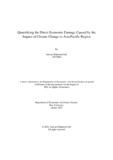| dc.contributor.advisor | Khan, Wasiqur Rahman | |
| dc.contributor.author | Safi, Safwan Mahmood | |
| dc.date.accessioned | 2022-05-18T06:09:18Z | |
| dc.date.available | 2022-05-18T06:09:18Z | |
| dc.date.copyright | 2022 | |
| dc.date.issued | 2022-01 | |
| dc.identifier.other | ID 19375004 | |
| dc.identifier.uri | http://hdl.handle.net/10361/16638 | |
| dc.description | This thesis is submitted in partial fulfillment of the requirements for the degree of Master of Science in Applied Economics, 2022. | en_US |
| dc.description | Cataloged from PDF version of thesis. | |
| dc.description | Includes bibliographical references (pages 46-52). | |
| dc.description.abstract | Global warming or climate change has amplified the number of natural disasters around the world. Natural disasters include floods, various forms of storms, cyclones, heat waves, drought, wildfires etc. Two important indicators of global warming or climate change are rise in average global temperatures and variability in global rainfall. This paper examines the anthropogenic link between global GHG emissions and climate change indicators (temperature and precipitation levels) and natural disasters.
The Asia Pacific region has experienced the brunt of these natural disasters in recent decades and is counting billions of dollars in direct economic damage. Could there be a relationship between the aforementioned changes in climate and the rise in natural disasters in the Asia Pacific region? This paper looks at two important climate change indicators (temperature and precipitation) and tries to quantify the value of economic damage caused by the disasters annually.
In cointegration analysis under ARDL framework, there is a long-run association between the increase in direct economic damages in USD and climate change indicators. Global average temperature shows a positive and significant impact on economic damages. Furthermore, inspection of the short run relationship in an ECM model also displays a positive and significant relationship between one lag period of global average temperature and economic damage values. Granger causality examination corroborates the findings and reports a uni-directional causality running from global average temperature and economic damage value.
In conjunction with evidence from the literature that it is “very likely” that increases in global temperature, caused by increasing release of GHG in the atmosphere, is altering the climate system suggests a connection between economic damage caused by the natural disasters observed in the region and global warming. | en_US |
| dc.description.statementofresponsibility | Safwan Mahmood Safi | |
| dc.format.extent | 55 pages | |
| dc.language.iso | en | en_US |
| dc.publisher | Brac University | en_US |
| dc.rights | Brac University theses are protected by copyright. This may be viewed from this source for any purpose, but reproduction or distribution in any format is prohibited without written permission. | |
| dc.subject | Global warming | en_US |
| dc.subject | Climate change | en_US |
| dc.subject | Natural disaster | en_US |
| dc.subject | Economic damage | en_US |
| dc.subject | ARDL | en_US |
| dc.subject | Granger causality | en_US |
| dc.subject.lcsh | Climatic changes -- Economic aspects. | |
| dc.title | Quantifying the direct economic damage caused by the impact of climate change in Asia Pacific Region | en_US |
| dc.type | Thesis | en_US |
| dc.contributor.department | Department of Economics and Social Sciences, Brac University | |
| dc.description.degree | M. in Economics | |

